Futuremark
PCMark 7
Universal PCMark 7 contains an individual
standard disk system. It’s not a synthetic test, but it bases on the actual
apps. This standard can create typical disk-using script and measure how fast
the speed in which they’re completed for common tasks. Starting with 1.4.0
version, PCMark 7 drive tests the result of processing system without
calculating any delay in the process of lining the commands. New results like
that are not compatible to the old one, but the differences between the
different efficiency numbers of SSD have become more obvious. That’s the
reason why we decide to switch to the new version for the testing session from
now on.
We run PCMark 7 on “steady” SSD, that’s an
achievable status in the actual computing system at most of the time. their
operations in this case is affected not only by the controller or flash memory
speed but also by the efficiency of their internal algorithms to fight against
the performance reduction.

PCMark
7
Futuremark programmers seem to be extremely
fond of SandForce-platform SSD. Using the compressed data in testing trace,
they help the SF-2281 controller obtain the highest performance rate. So, it
will be inaccurate to compare SandForce-platform SSD to other models using PCMark
7, but we can compare the SSDs in each group. And Kingston SSDNow V300 is not
highly rated in this comparison. It’s slower than the other SandForce-platform
solution, making us doubt some limitations in its software which displays in
the actual apps. After all, SSDNow V300 is an entry-level product and expected
to be slower than other solutions with SF-2281 controller.
Now let’s check the individual tests to
have a more detailed picture about what our SSDs are able belonging to
operational load:

Windows
Defender speed

Image-importing
speed

Video
editing speed
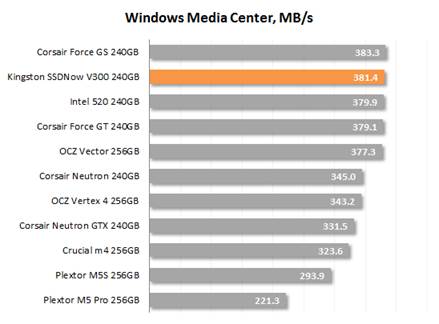
Music
playing speed
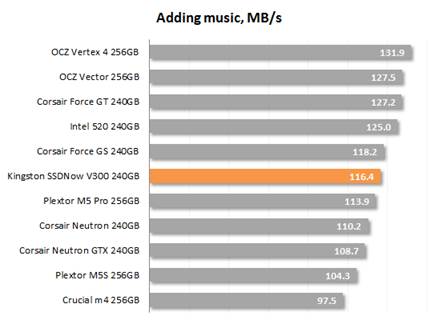
Music
copying speed
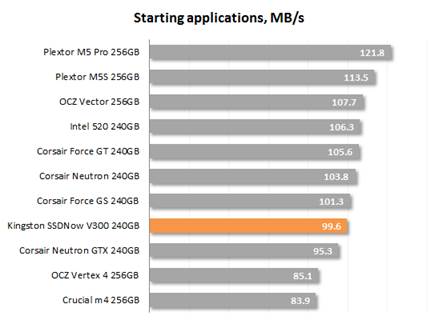
App
startup speed

Game-running
speed
The result is also the same to the PCMark tests.
Kingston SSDNow V300 should only be compared to Intel SSD 520, Corsair Force GT
and Corsair Force GS. And it turns out to be slower than all of them. In fact,
it can only be best-suited for the other SF-2281-platform solutions at
consecutive read-write process, which means that when processing multi-media
files. When taking random-access address into account, Kingston SSDNow V300 is
worse than other SSDs with the same controller.
Intel
NAS Performance Toolkit
Intel NASPT is a system from the testing
subsystem using actual using scripts. The same to PCMark 7, Intel NASPT reproduces
the preset operating marks of the drive and measure the fast speed of the
drives when performing. However, the default marks are designed for the storage
device network rather than for SSD. So in our test, we replace them by the
specially-developed Benchmarking Suite SSDs in which provides more relevant using
scripts such as compressing and decompressing files, compiling big projects,
copying files and folders, downloading the 3D-class game, installing software,
creating a series of images, looking for a digital library for the data,
releasing the mass-apps and transcoding videos.
The same to PCMark 7, this standard
benchmark shows us evidence about real-time life for a sub-disk system
performance. Here, SSDs are one more time tested at their “steady” status.

INASPT,
SSD Benchmark Suite
Intel NASPT seems to offer a more complete
picture about SSD efficiency and the SandForce-platform products is certainly
incredibly fast here. However, we can see that the custom software helps Intel
520 and Kingston SSDNow V300 perform faster than the products. SSDNow V300 is
only slower than the topping rivals which were recognized in the diagrams, so
it turns out that the SF-2281 platform us the fastest solution from Kingston right
now.
Aside from the standard average scores, we
would also like to offer you the results of the specific using script, in which
display, where Kingston SSDNow V300 can actually shine. Note that data-transferring
speed is higher than III-bandwidth SATA interface in some of the sub-test.
That’s because INASPT is an advanced test that uses the standard Windows function
to access the sub-disk system. As a result, the memory mechanisms of the OS
also affect the result.

File-compressing
speed

Compiling
speed
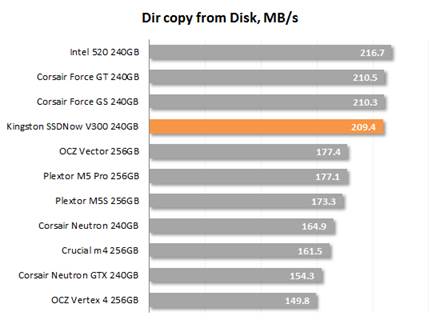
Speed
of copying files directly from disk
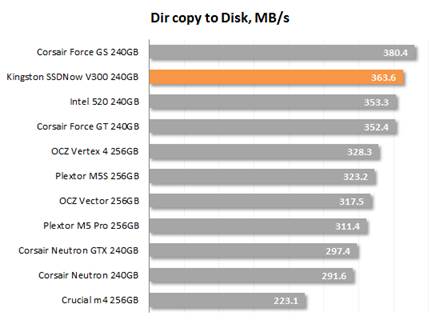
Speed
of copying files directly to disk
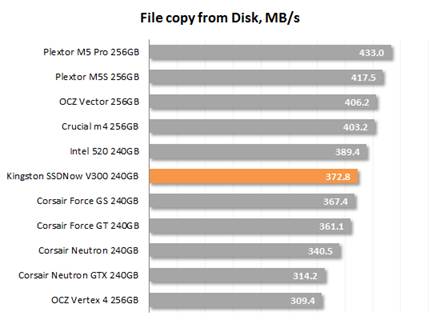
Speed
of copying file from disk
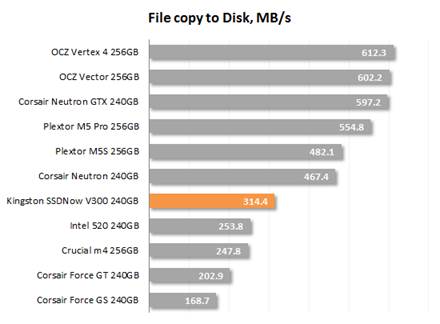
Speed
of copying files to disk

Game-launching
speed

Installing
speed
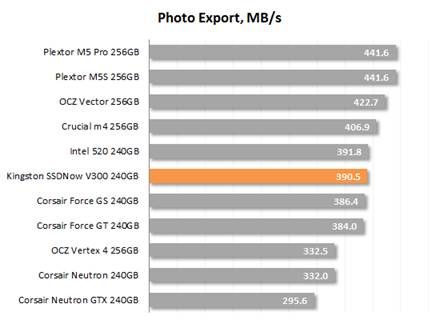
Photo-exporting
speed
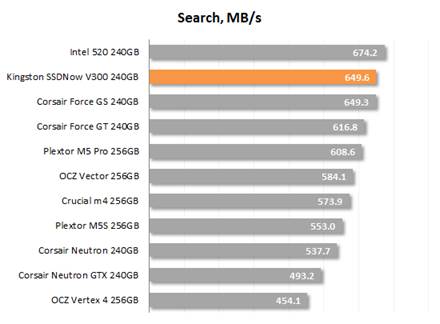
Searching
speed

Boosting
speed

Video
transcoding process
SF-2281 controller is not a new one, it
hasn’t outdated yet. It can compete with other platforms in actual apps,
especially when there’re lots of performed reading addresses. That’s the reason
why a SandForce-platform SSD is a pretty good solution so far.
Compared to the same offers from other
brands, Kingston SSDNow V300 is a good choice. It’s only faster than the common
SSD which bases on SandForce with 24nm or 25nm of syncing flash. In fact, it’s
only inferior to Intel 520 which is supported by its custom software.
File-copying
speed
We use the AS SSD 1.7.4739.38088 version to
score the copying speed of different types of files in a single zone of the
size of the entire SSD hard drive. The SSDs is tested in their stable status.
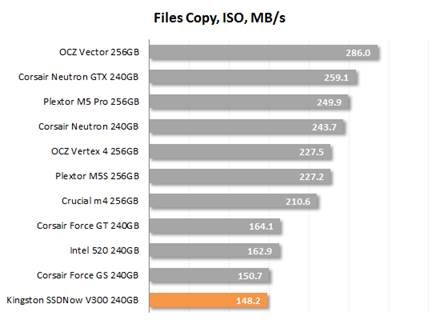
Result
of copying files, ISO

The
result of copying files, programs
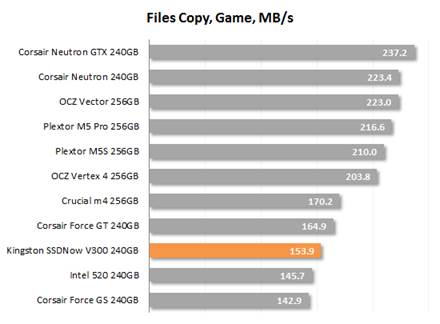
The
result of copying files, games
Kingston SSDNow V300 is extremely slow
here, which looks like any other product with SF-2281controller. It can be
predicted thanks to the method of reduplicating reading and writing files at
the same time. and while the SandForce-platform SSD has a good result in
reading process, the writing process push it lower so they’re ranked at the
bottommost of the diagram.
Conclusion
To be honest, we’re pretty prudent to the SandForce-platform
SSD. Besides their previous software gaps which take lots of time to be fixed,
we don’t actually like the sensitivity with the performance reduction because TRIM
is imperfectly performed while compressing their on-the-fly data, which is only
good in marketing perspective because it allows the makers set the impractically
high speed. Therefore, right after the appearance of the alternative version,
we prefer it on the SandForce platform.
Though, Kingston SSDNow V300 is a special
case. It can even change the awareness of us about the SandForce platform in
general. Kingston has changed the priority for this product, the position of
which is a product which doesn’t cost more than a high-performance SSD being
not equipped with the fast 19nm flash MLC NAND memory of Toshiba with Toggle
Mode interface. Moreover, the makers have developed custom software that helps SSDNow
V300 performs almost as fast as the Intel 520 processor in the actual apps. as
a result, this SSD stands out with an incredibly attractive price for each
stored gigabyte while being faster than most of the SandForce-platform products.
That’s especially good can comparable to the flagship products, such as in a
typical load of a system drive. So, if you’re looking for a product with the
best price/efficiency ratio, Kingston SSDNow V300 must be one of the first in
your list.
The only thing you need to catch is that SSDNow
V300 has shorter longevity than what regulated for different SSDs at this
product segment. Though that’s proper for a cheap product, you need to aware of
that.
|
Official
technical specs of 240GB models are as follows
·
Controller: SandForce SF-2281
·
Interface: SATA 6Gbps
·
Flash memory: synchronous 19 nm Toggle Mode
MLC NAND
·
Capacity: 240 GB
·
Consecutive read speed: up to 450 MB/s
·
Consecutive write speed: up to 450 MB/s
·
Random read speed (4 KB blocks): 85,0000 IOPS
·
Random write speed (4 KB blocks): 43,0000 IOPS
|